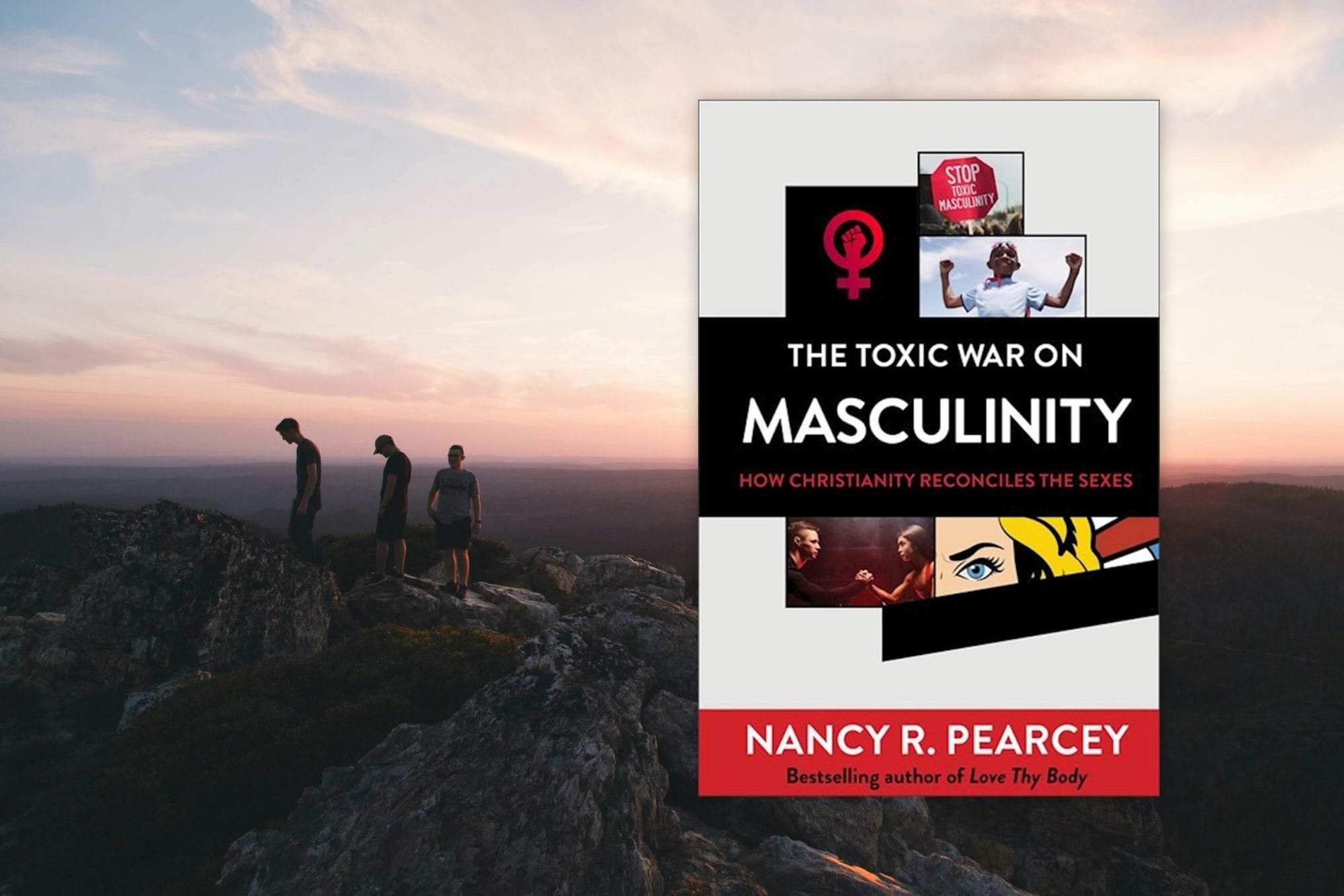The Toxic War on Masculinity
Is masculinity inherently toxic?
In her book The Toxic War on Masculinity: How Christianity Reconciles the Sexes (Baker Books, 2023), Nancy Pearcey answers that question by challenging the prevailing narrative in our culture regarding men. Pearcey makes the case for a renewed understanding and practice of authentic, biblical manhood through historical analysis, extensive research, and a look into timeless biblical principles applicable today.
The concept of ‘toxic masculinity’ is certainly pervasive in our culture today; you hear the term used in just about every corner of society. But where does this concept come from? “How did the idea arise that masculinity is dangerous and destructive?” Pearcey asks, pointing to cultural and historical shifts and how, through these, the secular script on masculinity turned toxic.
Understanding How We Got Here
According to Pearcey, the Industrial Revolution was pivotal in transforming society’s view of men. In the Colonial era, work and family life were integrated, allowing men to be present and active in the home. The Industrial Revolution “separated one’s work from the rest of his living, severing the relationship between production and the family,” Pearcey writes. This separation led to a growing perception of men as detached from their families, further exacerbated by the rise of cowboy culture and the valorization of the “lone, rugged individual.”
The Romanticism and Victorian eras further complicated these perceptions by idealizing the home as a haven from the harsh realities of industrial life and relegating it as a female domain. Men were increasingly seen as brutes in need of civilization by their morally superior wives. This narrative persisted into the modern era, where secular and cultural movements have continued to perpetuate the stereotype of men as inherently flawed.
Pearcey examines these historical shifts critically, noting, “In the nineteenth century, the ideology of separate spheres suggested that men belonged in the public sphere of work and politics, while women belonged in the private sphere of home and family.” This dichotomy, she argues, contributed significantly to the contemporary crisis of masculinity.
What it Means to Be a Man: Two Competing Scripts
Central to the book’s overall theme is Pearcey’s distinction between what she terms the Good Man and the “Real” Man.
Here’s how she makes that distinction:
In Play the Man, Washington, DC, pastor Mark Batterson says, “The image of God is our original software, sin is the virus.” The challenge is to sort out which definitions of manhood are part of the original software and which are the virus. Which belong to God’s original design and which are products of sin?
We might say societies hold two competing scripts for what it means to be a man. Sociologist Michael Kimmel highlights the contrast with an ingenious experiment. He started by asking cadets at West Point what it means to be a good man. If someone delivers a eulogy and says, “He was a good man,” what does that mean? The cadets had no trouble answering: “Honor, duty, integrity, sacrifice, do the right thing, stand up for the little guy, be a provider, be a protector.” Be responsible, be generous, give to others.
“Where did you learn that?” Kimmel asked. The cadets answered, “It’s everywhere. It’s our culture…it’s the Judeo-Christian heritage. It’s in the air we breathe.” Men seem to be innately aware of the software that God coded into the male character.
Kimmel then asked a follow-up question: “What does it mean if I tell you, ‘Man the f*** up! Be a real man.’”
The cadets shouted, “Oh no, that’s completely different.” To be a real man means to be “tough, strong, never show weakness, win at all costs, suck it up, play through pain, be competitive, get rich, get laid.”
Men everywhere seem to experience tension between what they themselves define as the good man and the way the surrounding culture pressures them to be a real man. They sense the contradiction between the software and the virus.
The problem with the stereotype of the “Real” Man is that it is one-sided. When separated from a moral vision of the Good Man, it can easily degenerate into sexism, dominance, entitlement, and contempt for those perceived as weak—traits we can all agree are toxic. […] When Christians promote a biblical moral vision—the Good Man—they are not imposing an alien standard on men. They are encouraging them to follow their own conscience, to be uncompromising in doing what they instinctively know is right.
Pearcey asserts that “the real problem is not an inherent flaw in masculinity itself. It’s that American society has become secularized and has lost the biblical vision of manhood.” She shatters modern stereotypes of men, especially evangelical men, by pointing out the statistical data that reveals that authentically committed Christian men are often the most loving and engaged husbands and fathers, with the lowest rates of divorce and domestic violence.
Reclaiming Biblical Manhood
Pearcey turns to biblical teachings to reclaim a better vision of masculinity. She emphasizes the biblical model of headship, which she describes not as a position of power but as a role of responsibility and selfless leadership. “A husband, instead of commanding his wife and children to fulfill his desires, has a responsibility to selflessly lead the family towards their good,” she explains.
Pearcey backs her argument with sociological data showing that devout Christian men who adhere to these biblical principles tend to have healthier and happier marriages and families than their secular and nominal Christian counterparts. “Many nominal men hang around the fringes of the Christian world just enough to hear the language of headship and submission but not enough to learn the biblical meaning of those terms,” Pearcey notes, highlighting the importance of a proper understanding and practice of what the Bible teaches men to be.
Pearcey advocates men building strong, loving relationships with their families and other men and fostering marriages marked by mutual respect and emotional engagement. She argues this is a crucial step in combating negative stereotypes and promoting a healthier, more biblical vision of masculinity. Pearcey writes, “The success of a marriage does not rest on external factors such as income or education. It rests on moral and spiritual factors like character and integrity.” This emphasis on internal virtues underscores her broader argument that true masculinity, as defined by biblical principles, is inherently good and beneficial for society.
Committed Christian men are less likely to engage in abusive behavior compared to their secular and nominal Christian peers. Nevertheless, Pearcey does not shy away from addressing the serious issue of domestic abuse, something often cited as a reason to condemn masculinity as a whole. She acknowledges the problem and gives guidance on best practices for cases where there is abuse and how church leaders can respond appropriately.
Masculinity as a Good Gift from God
Pearcey argues that the solution to toxic masculinity is not to vilify or reject men but to embrace the virtues of the Good Man. She calls for a return to the biblical principles of responsibility, self-sacrifice, and relational intimacy, which can transform men into loving husbands, engaged fathers, and responsible community members. Pearcey challenges the dominant cultural narrative about men and gives a hopeful vision of what men can be. Instead of letting culture define masculinity, Pearcey argues that we need to reclaim the biblical ideal of manhood. “Our families and communities will not be strengthened and renewed by an emphasis on merely stereotypical men. They must be led by men of virtue, responsibility, and love.”
In the book’s epilogue, Pearcey reminds us that true masculinity is not intrinsically toxic. It is a good gift from God.
Even men who may not be Christian still retain vestiges of the biblical teaching that masculinity consists in Christlike sacrifice for the sake of others. Men seem to intrinsically treat masculinity as the call to die so others may live—the highest form of self-sacrifice. Jesus said, “Greater love has no one than this: to lay down one’s life for one’s friends (John 15:13). That principle seems to be built into men’s created nature. Men know what it means to be a Good Man, even when a secular culture pressures them to fit into its mold of a “Real” Man. Manhood is fulfilled in its opportunity to serve and protect.
Masculinity is not originally or intrinsically toxic. Duty and compassion are masculine virtues, integral to the male character. True masculinity is a good gift from God, and we should be grateful for the men who embody it.
The Toxic War on Masculinity helps point the way forward toward a biblical ideal of masculinity and a view of manhood that is a blessing for men, women, children, and society as a whole. We can listen beyond the cultural noise and return to a biblical understanding that honors—rather than vilifies—men and their unique contributions. The book is an excellent guide in helping men strive toward a manhood that is grounded and centered on Christ. Or, as Pearcey puts it, “Men need to be reminded that their identity is not in their job, their income, or their social status. It is in Christ.”


